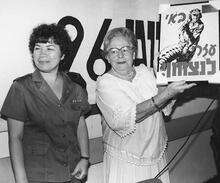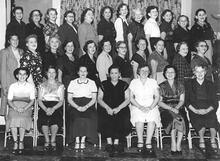Bertha Beitman Herzog
Bertha Beitman Herzog’s leadership of women’s organizations in Cleveland created a safety net for women and children throughout the region. She headed the immigration department of the local Council for Jewish Women (CJW) from 1908 to 1909 and chaired the League of Women Voters of Cleveland’s international relations committee. She led the local CJW from 1920 to 1924 and helped it rejoin the National Council of Jewish Women. From 1928 to 1930 she served as the first woman president of the Jewish Welfare Federation in Cleveland. In 1928 she also founded the Maternal Health Association (a birth control clinic) and served on its board through the 1940s. She also helped fund Cleveland College’s night classes for nontraditional students. In 1941, she received the Charles Eisenmann Award for outstanding community service.
Bertha Beitman Herzog was an active participant in local and national women’s associations in Cleveland, Ohio. From 1928 to 1930, Herzog served as the first woman president of the Jewish Welfare Federation (later the Jewish Community Federation) in Cleveland and received the Charles Eisenmann Award for outstanding community service in 1941. She helped create several local organizations for Jewish women, including the Cooperative League of Jewish Women’s Organizations of Cleveland (later the Cleveland Federation of Jewish Women’s Organizations), which she chaired in 1926. Herzog presided over the local Council of Jewish Women (CJW), later the National Council of Jewish Women (NCJW), Cleveland Section, from 1920 to 1924, and served as women’s cochair for the National Conference of Christians and Jews.
Jewish Philanthropy
Bertha Beitman Herzog was born in Washington, Indiana, to Emanuel and Molly Beitman. She moved to Cleveland Heights, Ohio, after her marriage to Siegmund Herzog on March 1, 1900. Her husband later became vice president and treasurer of H. Black, a local clothier. He died in 1943.
A member of Suburban Temple, Herzog was among the earliest participants in prominent local cultural and civic groups such as the Women’s City Club of Cleveland and the Women’s Committee of the Cleveland Orchestra. During her tenure as president of CJW, the council grew to three thousand members and rejoined the NCJW after a thirteen-year hiatus of independence. Under Herzog’s leadership, the CJW initiated its Monthly Bulletin and developed efforts such as Martha House (inc. 1919) and the Jewish Big Sister Association to help single Jewish women and girls. After leaving the helm of the Cleveland section, Herzog assumed the chair of the NCJW’s committee on communal and civic affairs. From 1928 to 1929, she served the local group on the executive board and was designated an honorary trustee in 1930.
International Advocacy and Legacy
Well-traveled in Europe, Herzog promoted the study of world affairs among Cleveland women of all faiths and ethnic backgrounds. She headed the immigration department of the CJW from 1908 to 1909, chaired the League of Women Voters of Cleveland’s international relations committee, participated in a women’s discussion group on world affairs in the 1920s (one predecessor of the Cleveland Council on World Affairs), and, in 1923, served as vice president of the Council for the Prevention of War (later the Women’s Council for the Promotion of Peace), a combined effort of local women’s organizations.
Health and education, especially for women, also occupied Bertha Herzog’s reform energies. She served on the board of trustees of Cleveland’s pioneer birth control clinic, the Maternal Health Association (later Planned Parenthood of Greater Cleveland), from its founding in 1928 until the 1940s. Herzog nourished parochial education as a member of the board of trustees of the Bureau of Jewish Education. She promoted professional training for women, serving on various committees at the School of Social Sciences at Western Reserve University (now Case Western Reserve University) from its founding until the late 1940s. Herzog also supported the fledgling Cleveland College in its efforts to attract nontraditional students through night classes.
Bertha Beitman Herzog died at her home in Cleveland on July 9, 1958. She was cremated and her remains are located at the Cleveland Temple Memorial.
Abbott, Virginia Clark. The History of Woman Suffrage and the League of Women Voters in Cuyahoga County 1911–1945 (1949).
Gartner, Lloyd. History of the Jews of Cleveland (1978).
Herzog, Bertha Beitman. “Civic and Communal Affairs.” Jewish Woman (April 1924). Reprinted in National Council of Jewish Women, Cleveland Section, Monthly Bulletin, no. 5 (1924): 16.
Meyer, Jimmy E.W. “Birth Control Policy, Practice, and Prohibition in the 1930s: The Maternal Health Association of Cleveland, Ohio.” Ph.D. diss., Case Western Reserve University (1993).
Council of Jewish Women. Monthly Bulletin 1, no. 1 (January 1924): 2, and 1, no. 5 (May 1924), and 3, no. 6 (March 1926), 2.
Neely, Ruth J. Women of Ohio. Vol. 3 (n.d.).
Obituaries. Cleveland Plain Dealer, July 10, 1958, 34, and Jewish Independent, July 11, 1958, 1+.
Obituary of Siegmund Herzog. NYTimes, January 14, 1943.
Rose, William Ganson. Cleveland: The Making of a City (1950).
Van Tassel, David, and John Grabowski, eds. Dictionary of Cleveland Biography (1996), and Encyclopedia of Cleveland History (1987), and Encyclopedia of Cleveland History. 2d ed. (1996).
WWIAJ (1926, 1938).










